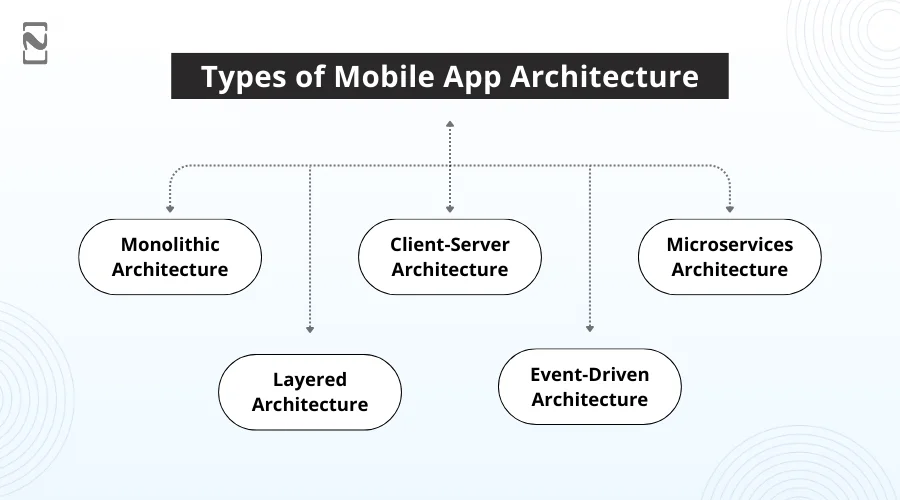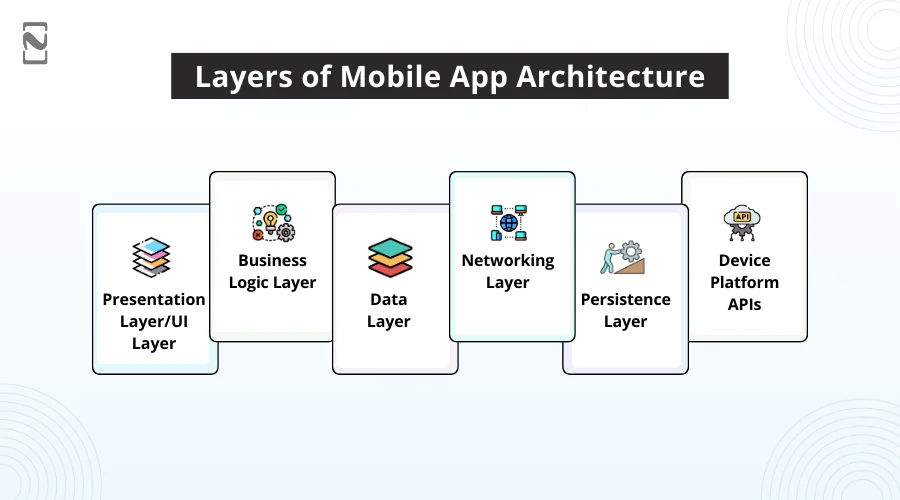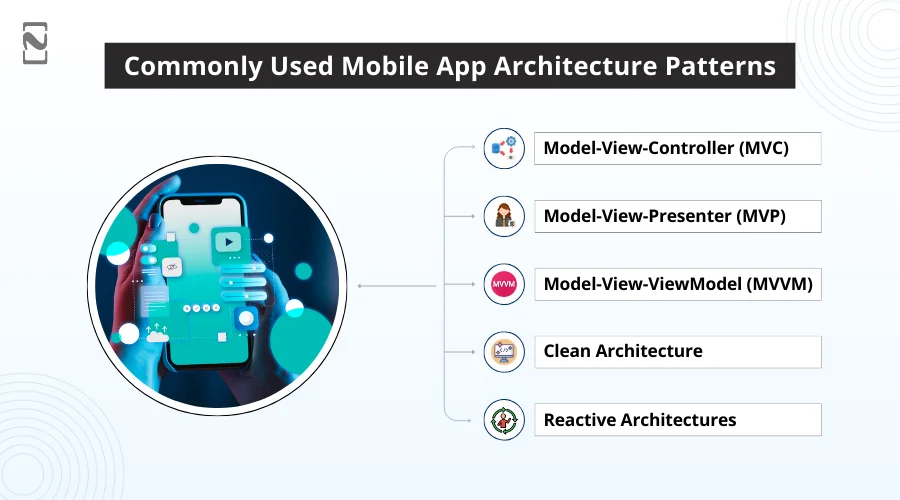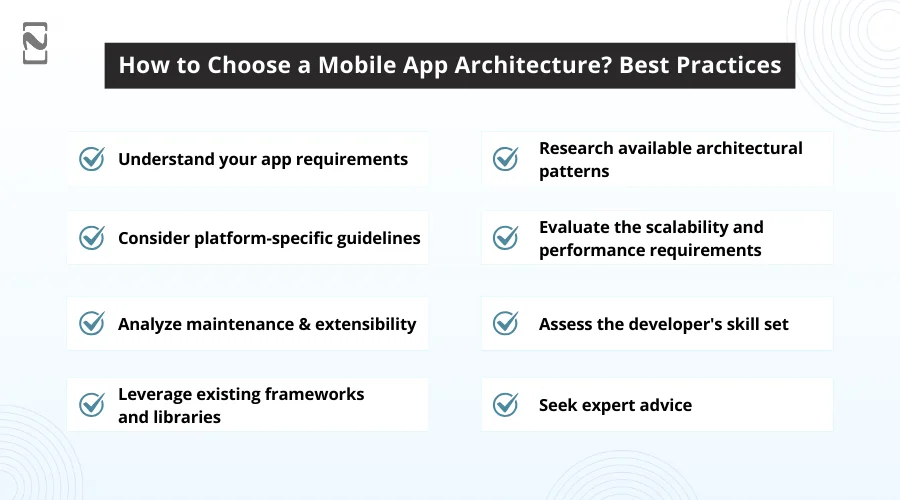The rate of mobile app failure has grown significantly in the past few years. While people tend to believe that it is the rise in market competition, one of the core reasons behind this decline is not paying attention to the mobile app architecture.
It is one of the most crucial yet underestimated elements of the development process. It is the architecture of your application that can make or break your application.
So what is Mobile Architecture?
Well, the architecture deals with the arrangement and interaction between the different components and modules. It is a blueprint that helps you app ecosystem with all the technologies planned and implemented as per the requirements.
A well-designed architecture allows for code reusability, maintainability, scalability, and extensibility. This makes it easier for developers to create, test, and maintain the concerned application.
However, that is just the tip of the iceberg. There’s a lot to learn about mobile app architecture, and if you plan to build an application of your own, then this is the guide that will equip you to understand mobile app architecture’s importance & how you can decide on one..
So, without further ado, let’s get right into it!
Understanding Mobile App Architecture
Let’s try and understand the concept of mobile app architecture in detail. A mobile app architecture includes everything that is required for development.
From the technologies to the framework, and data flow to UX design, which is also the reason why users have doubts about the concept..
You see, mobile app architecture is often confused with the mobile app tech stack. Even though the two concepts have things in common, they aren’t the same thing at all.
For instance, a tech stack refers to the technologies, like languages, frameworks, toolkits, etc, used for development. Coming to mobile app architecture, we already discussed what they are.
In short, architecture concerns every component of the app and also covers outside elements like business requirements.
As far as the impact of a mobile app architecture is concerned, it is quite significant. With a defined architecture for your app, you can not only develop a solution accurately, but also reduce development time and maintenance costs. The idea is to lay down the foundation so strong that the interoperability of the app improves.
Now that we are aware of the key differences and the impact of the application, let’s move forward and explore different types of mobile app architecture that you commonly see in the industry.
Types of Mobile App Architecture
Each business app development project has its own unique needs and thus requires a specific mobile app architecture to fulfill its needs.
Consequently, there are different types of mobile app system architectures available in the market. You can either choose one of these or create one of your own.

Speaking of which, let’s look at some commonly used app architectures.
1. Monolithic Architecture
Here, the entire mobile app is developed as a single, self-contained unit. Thus, the name monolithic app architecture.
Moreover, all the modules and components of the app are tightly coupled and run within a single process. As such, they are relatively simple and easy to develop, but can become difficult to maintain and scale as the app grows.
Because of that, it is falling out of favor.
2. Client-Server Architecture
In a client-server mobile app architecture, the solution is a client that communicates with a server over a network.
The server handles tasks such as data storage, business logic, and processing, while the client app focuses on the user interface and user interaction.
The benefits you get with this one are better scalability and separation of concerns.
3. Microservices Architecture
Microservices architecture is the one used by top platforms like Netflix, Amazon, and Instagram.
This mobile app architecture enables apps to be a combination of smaller, independent services known as microservices.
Each microservice focuses on a specific business function and can be developed, deployed, and scaled independently.
Communication between microservices typically occurs through APIs or message queues.
Therefore, this mobile app architecture allows for high scalability, fault isolation, and flexibility, but it adds complexity in terms of service coordination and deployment.
4. Layered Architecture
As the name suggests, here the app is divided into multiple layers.
Each layer is responsible for a specific set of functions. Common layers include presentation, business logic, and data access. We shall be discussing the various layers of architecture later down the line.
This architecture promotes separation of concerns, modular development, and ease of testing.
5. Event-Driven Architecture
Event-driven architecture enables different components to communicate using events.
Therefore, when an event occurs, it triggers a message to the other concerned component. The technology is especially recommended for real-time, i.e., on-demand apps.
While these types are approach-oriented and can be chosen according to the requirements, there are platform-based app architectures as well that you can opt for.
The idea behind this classification is to give the developers enough freedom to choose their course of action, as per the demands of the project.
Layers of Mobile App Architecture
The types of architectures shared above all have one thing in common: they all have the same layers.
To understand the working of a mobile app architecture, one must first understand the different layers of the technology being used in deciding the final architecture.

Here are the layers of mobile app architecture –
-
Presentation Layer/UI Layer
This layer of the architecture deals with the user interface. This covers parts like the screen, viewing, as well as user interactions.
It is responsible for handling user input and information display, as well as communication with the other layers of the architecture.
As such, the latter covers components like fragments (Android), view controllers (iOS), or widgets.
-
Business Logic Layer
As the name implies, it is one of the most important layers of app architecture. As such, it houses all the core functionalities and the app’s rules.
It goes without saying, it is also responsible for business logic implementation, algorithm working, and manipulation of data.
With this level of authority over the application, this layer manages the app’s behavior, defining how data is used.
Lastly, it is also the layers that work as a barrier between the presentation layer and the data layer.
-
Data Layer
Appropriately named, this layer deals with data synchronization, storage, and retrieval. To enable this, it has components like data models, repositories, and data access objects
For that reason, this layer is responsible for communication with external data storage, APIs, as well as the database.
-
Networking Layer
The networking layer deals with, well, networking.
It communicates with the API and other external services. Thus, it is responsible for handling HTTP requests, sending/receiving data, and managing network connectivity.
-
Persistence Layer
This is a little more technical as this layer deals with data persistence, data storage (on-device), database management, file storage, caching, and so on.
It is the persistence layer that enables offline functionality and data synchronization at a larger level.
-
Device/Platform APIs
Each mobile app has APIs to enable additional functionality. It is this layer of functionality that enables API interaction.
So, these are the different layers of mobile app information architecture. With that out of the way, let’s move on and see how you can choose the right mobile app architecture.
Commonly Used Mobile App Architecture Patterns
Every mobile app has different needs, and that’s why they require different mobile app architectures. Regardless of the type, the architecture has to follow mobile app architecture patterns.
While a company can create its own patterns, there are some pre-set patterns to create a mobile app architecture.

Here are some of the most commonly used architectural patterns –
► Model-View-Controller (MVC)
This pattern separates the app into three main components:
- The model (data and business logic)
- The view (user interface)
- The controller (mediator between the model and view).
It is one of the most commonly used app architecture patterns that you see in a lot of
► Model-View-Presenter (MVP)
Similar to MVC, MVP mobile app architecture patterns separate the app into model, view, and presenter components. Moreover, the presenter acts as an intermediary between the model and the view.
The pattern handles user interactions and updates the UI. (This MVP should not be confused with MVP – minimum viable product.
► Model-View-ViewModel (MVVM)
MVVM is a mobile app architecture pattern where the model represents the data and business logic, the view displays the UI, and the view model acts as a bridge between them. Thus, it provides data to the view and handles user interactions.
► Clean Architecture
This mobile app architecture pattern emphasizes separation of concerns and dependency inversion. It consists of layers such as presentation, domain, and data, with each layer having its responsibilities and dependencies.
► Reactive Architectures
These architectures, such as ReactiveCocoa or RxJava, enable the reactive programming paradigm. They allow for handling asynchronous operations and data streams by using observable sequences and reacting to changes.
Knowing these common architecture patterns, you might have understood that different professionals and products work on different mobile app architecture patterns.
How to Choose a Mobile App Architecture? Best Practices
It can be difficult to identify the correct architecture, especially when you do not have prior experience with development.
Most of the businesses tend to rely on experts as they can guide better. However, there’s no harm in knowing more, right?
That is why we have curated a series of best practices that can serve as a roadmap for you to finalize the mobile app architecture optimally.

Here is the roadmap that you should follow to identify the correct mobile app architecture for the project –
1] Understand your app requirements
The first thing you need to do is understand the requirements of the app project. Therefore, you should consider:
- App complexity
- Expected traffic
- Real-time update requirements
- Specific security requirements
- Specific functionality or performance
Considering this architecture helps you choose the architectural patterns for your solution.
2] Research available architectural patterns
We discussed some architectural patterns at the beginning of the blog. Now, you need to decide which one to use for your development project.
Each mobile app architecture pattern has its pros and cons. So, research it and finalize which sits well with your project.
3] Consider platform-specific guidelines
Well, when you are developing a mobile app, you go with one of these options.
- Hybrid mobile app architecture
- Android mobile app architecture
- Flutter mobile app architecture
- iOS mobile app architecture
Each of the platforms has its one unique requirement. We’ll discuss this in detail later.
Coming back to the topic, it’s essential to consider the platform-specific guidelines and best practices. These guidelines can influence your architectural choices and ensure your app integrates well with the platform ecosystem.
4] Evaluate the scalability and performance requirements
Are you considering operations to grow? Well, if yes, you should think about potential scalability and performance requirements.
You see, if you expect a large number of users or anticipate the need for frequent updates and real-time interactions, you might need an architecture that supports scalability and responsiveness.
5] Analyze maintenance and extensibility
You should think about the long-term maintenance and extensibility of your app.
Choose an architecture that allows for easy maintenance, modular development, and the ability to add new features without introducing significant code changes or risking stability.
6] Assess the developer’s skill set
At the end of the day, it’s mobile app developers who will convert your idea into reality.
So, when choosing mobile app architecture, you need to consider their skill set and preferences.
Choosing an architecture that your team is comfortable with will streamline the app development process and help ensure the quality of the codebase.
7] Leverage existing frameworks and libraries
Evaluate the availability of frameworks, libraries, and tools that can support your chosen architecture.
Using established frameworks and tools can significantly reduce development time and provide a solid foundation for your app.
8] Seek expert advice
The best thing to do is to contact an app development company. They will give you expert advice and make the choice for architecture that much easier.
Through each of these practices, you will be able to decide on a mobile app architecture for your app. However, the things to keep in mind do not end with these steps.
There are several other factors that you need to focus on when choosing/developing a mobile app architecture.
Decisions like what kind of UI/UX you are building, or what the bandwidth will be, or what kind of device you are designing the app for, also make a significant difference.
Conclusion
Hope the information shared in this post gives you enough insights into what a mobile app architecture is, what its types, patterns, and layers are.
Mobile app architecture is a fundamental requirement for planning and executing your project.
Irrespective of what application you build or what kind of features you need, you must decide on the application architecture beforehand.
Hiring mobile app developers can also simplify the job for you; however, make sure you go for someone who has proven experience in the field, like Nimble AppGenie.
With that said, we have reached the end of this one.
Thanks for reading, Good luck!
FAQs
The architecture of a mobile app refers to its overall design and structure, including how its components are organized and interact with each other.
It determines how the app handles data, user interface, network communication, and other essential functionalities.
The best architecture for a mobile app depends on factors such as app complexity, platform (e.g., Android or iOS), development team expertise, and project requirements.
Some commonly used architectures for mobile apps include Model-View-Controller (MVC), Model-View-ViewModel (MVVM), and Clean Architecture.
The key components of a mobile app architecture typically include:
- User Interface (UI): Handles the presentation layer and user interactions.
- Business Logic: Contains the application’s core functionality and rules.
- Data Layer: Manages data storage, retrieval, and synchronization.
- Networking: Handles communication with external services or APIs.
- Navigation: Controls the flow and transitions between app screens or views.
There are various mobile application architectures, but two commonly used ones are:
Native Architecture: Involves developing separate codebases for different platforms (e.g., Java/Kotlin for Android and Swift/Objective-C for iOS). It offers high performance and platform-specific capabilities, but requires more development effort.
Cross-Platform Architecture: Involves using frameworks like React Native, Flutter, or Xamarin to develop a single codebase that can run on multiple platforms. It provides code reusability and faster development, but may have some performance trade-offs.

Niketan Sharma, CTO, Nimble AppGenie, is a tech enthusiast with more than a decade of experience in delivering high-value solutions that allow a brand to penetrate the market easily. With a strong hold on mobile app development, he is actively working to help businesses identify the potential of digital transformation by sharing insightful statistics, guides & blogs.
Table of Contents





No Comments
Comments are closed.